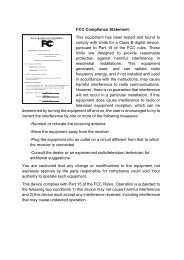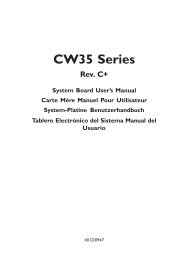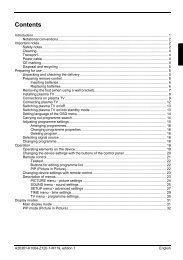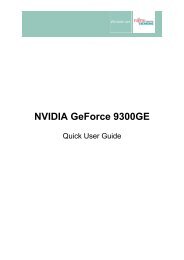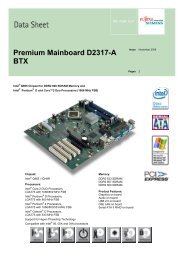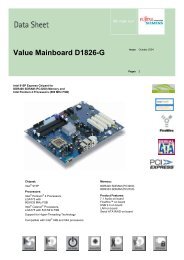Intel(R) Matrix Storage Manager User's Manual - Fujitsu UK
Intel(R) Matrix Storage Manager User's Manual - Fujitsu UK
Intel(R) Matrix Storage Manager User's Manual - Fujitsu UK
Create successful ePaper yourself
Turn your PDF publications into a flip-book with our unique Google optimized e-Paper software.
R<br />
RAID 5 (Striping with Parity)<br />
5 RAID 5 (Striping with Parity)<br />
A RAID 5 array contains three or more hard drives where the data is divided into manageable<br />
blocks called strips. Parity is a mathematical method for recreating data that was lost from a single<br />
drive, which increases fault-tolerance. The data and parity are striped across all the hard drives in<br />
the array. The parity is striped in a rotating sequence to reduce bottlenecks associated with the<br />
parity calculations.<br />
The capacity of a RAID 5 array is the size of the smallest drive multiplied by one less than the<br />
number of drives in the array. The equivalent of only a single hard drive is used to store the parity<br />
information, allowing for fault-tolerance with less than the 50% capacity reduction of RAID 1.<br />
For example, three 400 GB hard drives in a RAID 5 array will appear as a single 800 GB hard<br />
drive to the operating system.<br />
The primary benefits of RAID 5 include capacity and data protection. Because parity is used for<br />
data protection, up to 75% of the total drive capacity is usable. Further, any single drive can fail<br />
and it is possible to rebuild the data after replacing the failed hard drive with a new drive.<br />
However, the extra work of calculating the missing data will degrade the write performance to the<br />
RAID 5 volume while the volume is being rebuilt.<br />
The read performance of a RAID 5 array is greater than that of a single drive because data can be<br />
read from multiple disks simultaneously. Disk writes do not realize the same benefit because<br />
parity must be calculated and written to all the drives.<br />
To enhance the write performance of RAID 5, <strong>Intel</strong>® <strong>Matrix</strong> <strong>Storage</strong> <strong>Manager</strong> software has<br />
implemented a RAID 5 volume write-back cache and coalescer.<br />
The volume write-back cache allows writes to be buffered and improves coalescing. The cache is<br />
disabled by default, but can be enabled by the user through the <strong>Intel</strong>® <strong>Matrix</strong> <strong>Storage</strong> Console.<br />
An Uninterrupted Power Supply (UPS) is recommended for use if the cache is enabled.<br />
The coalescer allows write requests to be combined into larger requests to reduce the number of<br />
I/Os per write for parity calculations. The coalescer is enabled by default, and the user does not<br />
have the option to disable it.<br />
<strong>User's</strong> <strong>Manual</strong> 15




